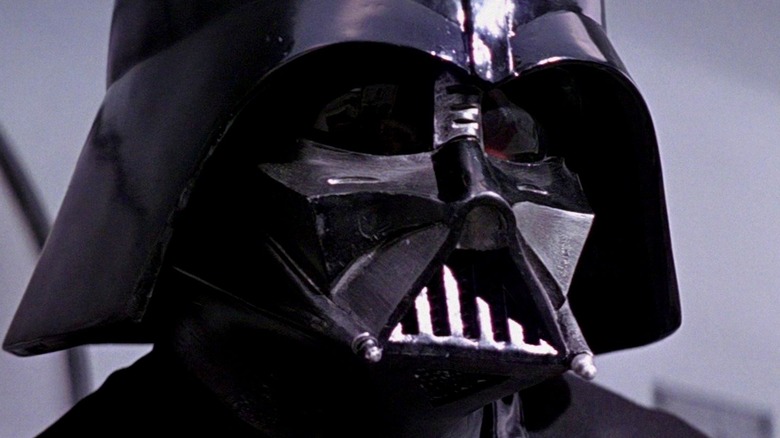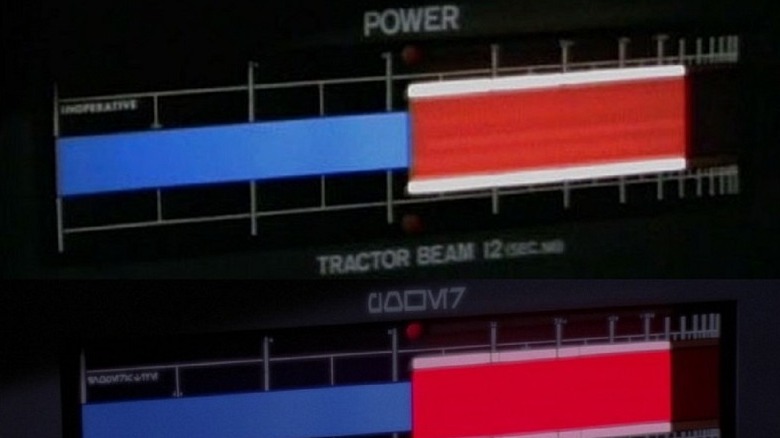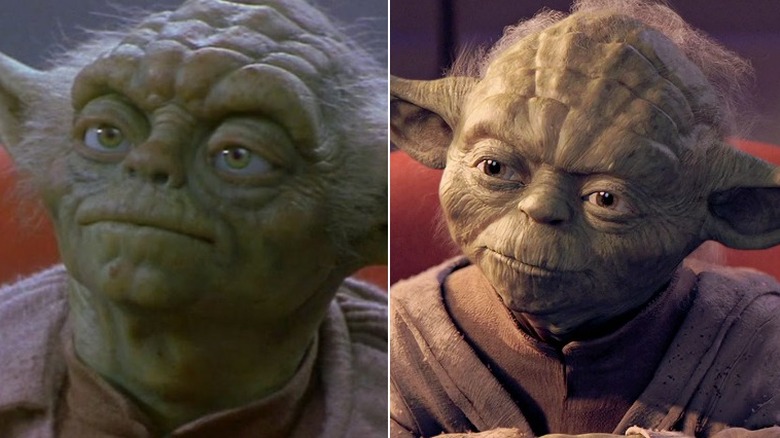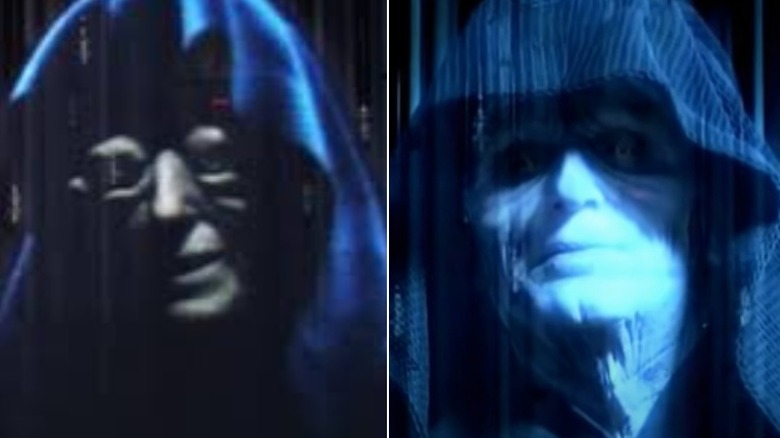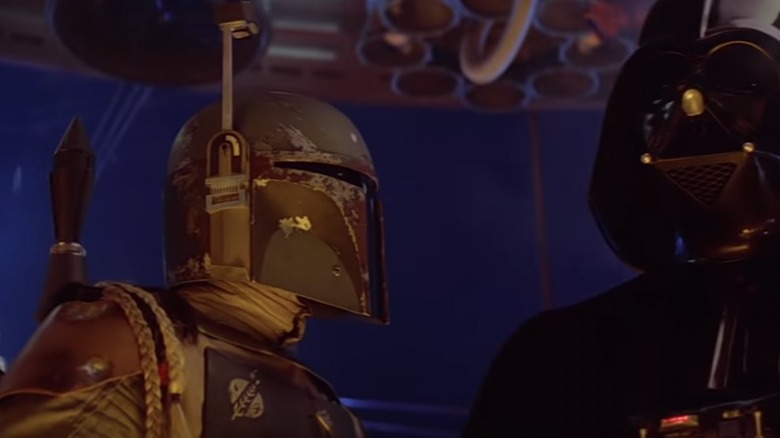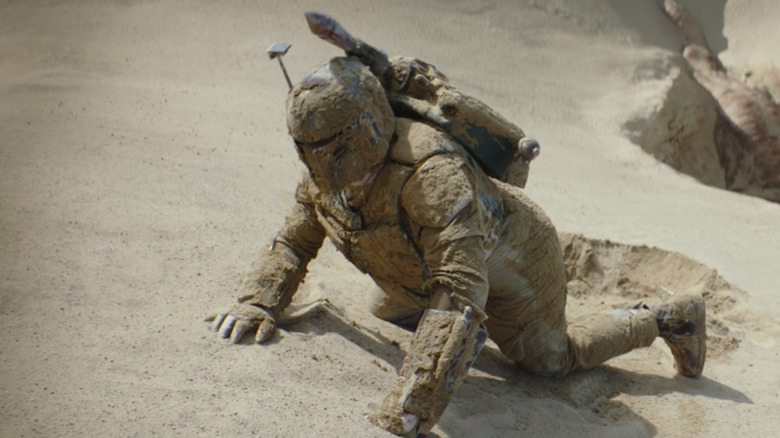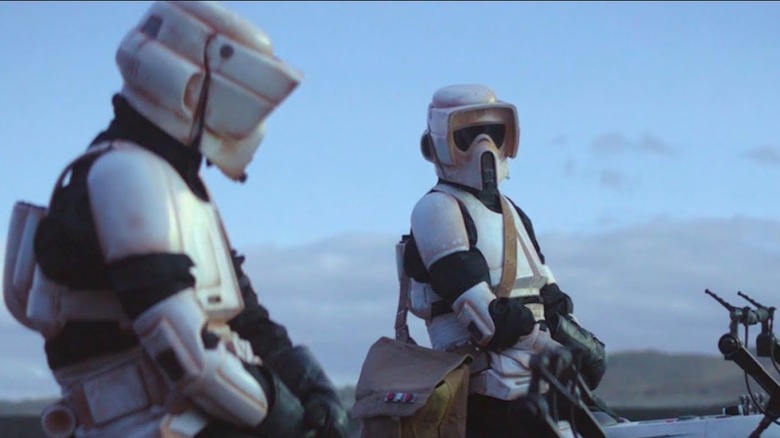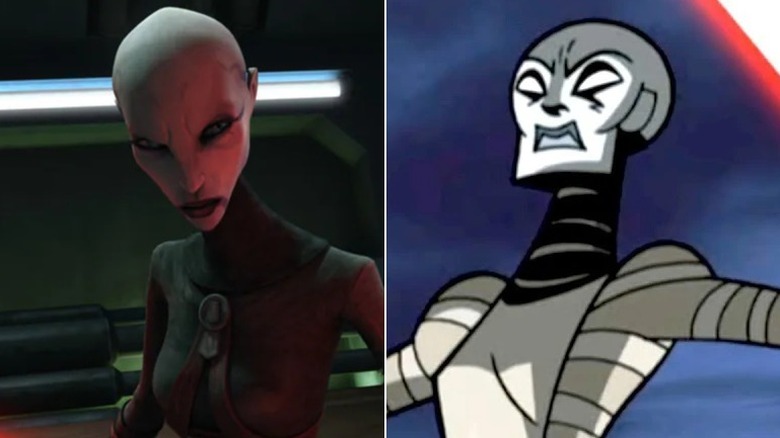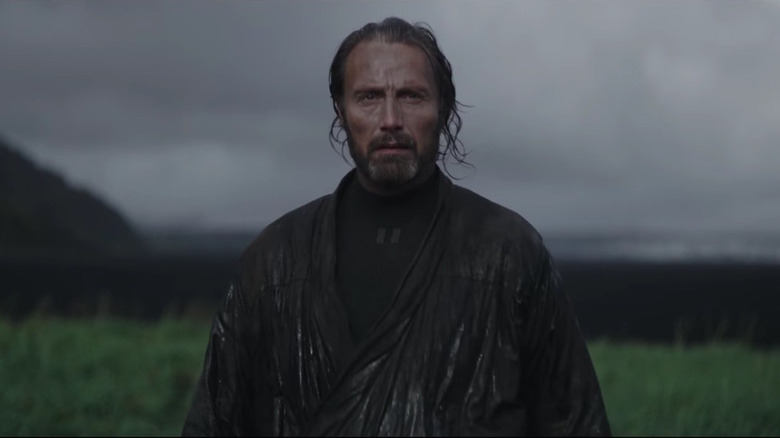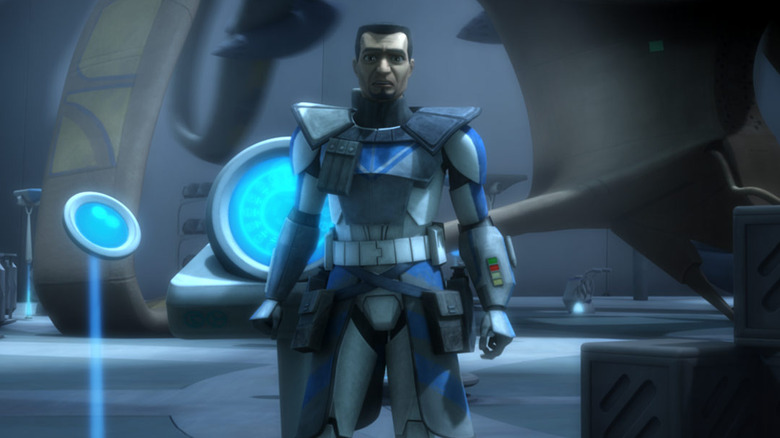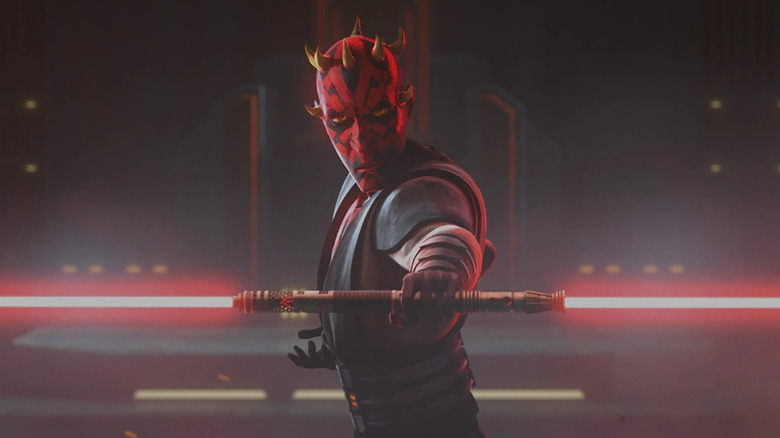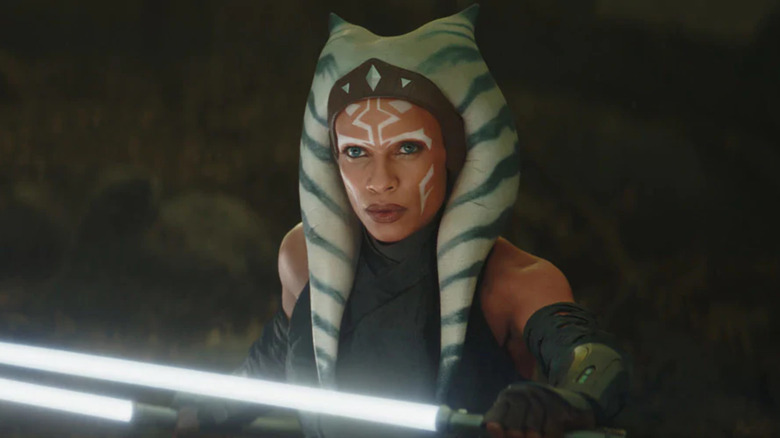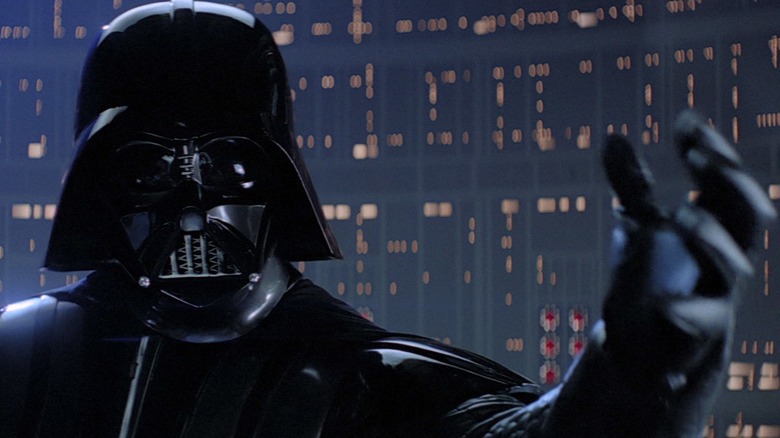Star Wars Changes That Made The Franchise So Much Better
Ever since George Lucas first wowed cinematic audiences with 1977's original "Star Wars," the series quickly went on to become one of the most beloved franchises there is. Comprised of numerous films, TV series, comic books, and video games, "Star Wars" boasts one of the most layered and expansive fictional universes of any cinematic series in existence.
With how many additions the series has seen over the years, "Star Wars" is also known for regularly updating, changing, or outright retconning certain aspects of its narrative or massive universe. Sometimes these are slight changes made for continuity's sake or to explain certain plot holes, like how the Empire overlooked the Death Star's exhaust port in "A New Hope." Other times, they are changes made as a result of re-released, revised editions of the films made by George Lucas, updating his movies and getting them closer to his original vision for the series.
As controversial as some of Lucas's changes have been in the past — such as the whole "Who shot first?" debate that continues to rage within the "Star Wars" fan community — other changes have been made for the better, increasing viewers' enjoyment of the "Star Wars" series even more than before. Here are some of the greatest changes made to the "Star Wars" universe that have made the franchise that much more enjoyable to watch.
The removal of English in the original trilogy
It's fair to assume that George Lucas had no idea how intricate and fully realized a universe he'd created with the original Star Wars trilogy. Over time, every facet of life within "Star Wars" would be worked out, right down to specific languages the characters spoke. Not unlike famous pop culture universes such as Middle-earth in "The Lord of the Rings" or the many worlds of the Federation in "Star Trek," "Star Wars" has its own language spoken by the series' characters, known as Galactic Basic Standard. When written down, Basic is transcribed into Aurebesh, the most commonly used alphabet system in the "Star Wars" galaxy.
Having been created after the release of the original "Star Wars" trilogy, Lucas went back and removed all instances of English labels used in his films and replaced them with Aurebesh symbols. It's a minor fix, but it does wonders by adding a smaller level of detail and authenticity for background scenes throughout the original trilogy, making it that much more immersive a viewing experience. Even more impressive is the fact that many of the Aurebesh characters used in the film actually translate to English, meaning that every phrase that appears in "Star Wars" means something unique — it's not just random alien symbols sprinkled haphazardly throughout the films.
CGI Yoda in The Phantom Menace
The film that kicked off the prequel trilogy, "The Phantom Menace," continues to rank as one of the lesser entries in the "Star Wars" series. Elements of the film were certainly strong, with the visuals alone aging remarkably well in the 20 years since its release, but one noticeably weak aspect of the initial film was the puppet used to portray Yoda.
As had been the case in the original trilogy, Yoda was initially featured on screen through the use of puppetry. Despite the movie's massive budget, though, the puppet version of Yoda that appeared in "The Phantom Menace" was somehow of far worse quality than the one previously used in Lucas's original trilogy.
Fortunately, Lucas patched this up when it came time for "Attack of the Clones." Realizing that Yoda would need to physically move around more in his lightsaber battle with Count Dooku, Lucas reverted to a CGI iteration of the Jedi Master that would appear in the final two films of the prequel trilogy. To smooth the continuity between the three films, he also went back and removed the puppet version of Yoda from "The Phantom Menace," digitally replacing him with the CGI version of the character that appeared in "Attack of the Clones" and "Revenge of the Sith."
The remastered Emperor in The Empire Strikes Back
One of the most popular changes made to Lucas's remastered version of "The Empire Strikes Back" was the insertion of Ian McDiarmid's portrayal of Emperor Palpatine into the re-released cut of the film. In the original release, the Emperor briefly appears in holographic form to converse with Darth Vader. Voiced by New Zealand stage actor Clive Revill and physically portrayed by a masked Marjorie Eaton, this version of the Emperor would look and sound nothing like the Emperor viewers later saw in "Return of the Jedi."
In fact, the design of Palpatine — infamously known for having chimpanzee eyes superimposed over the character's face — is often considered one of the rare flaws within the original cut of "The Empire Strikes Back." When it came time for Lucas's recut of the film decades later, he removed this rudimentary version of Palpatine and replaced it with McDiarmid, the actor who portrayed Palpatine in "Return of the Jedi," the prequels, and "The Rise of Skywalker."
It's one of the few changes Lucas made to the original trilogy that fans almost universally support, improving the Emperor's appearance in "The Empire Strikes Back" tenfold. It not only helps link the original and prequel trilogies together with improved continuity, but also gives viewers an additional opportunity to see McDiarmid as the enjoyably fiendish Emperor.
Boba Fett's voice change in the remastered Original Trilogy
Another change made in the remastered version of "The Empire Strikes Back" is the removal of actor Jason Wingreen's vocal performance as Boba Fett. While British actor Jeremy Bulloch wore the armor of the famous bounty hunter onscreen, the Brooklyn-born Wingreen dubbed Fett's lines (via The Hollywood Reporter) with an almost guttural, Clint Eastwood-esque growl. While certainly intimidating and keeping in line with the Western motifs for the bounty hunter, Lucas chose to replace Wingreen's vocal performance with Temuera Morrison, the actor who portrayed Jango Fett in "Attack of the Clones" and who later played Fett in "The Mandalorian" and "The Book of Boba Fett."
As Fett himself is a literal clone of Jango, it makes sense that Lucas would have Morrison voice the character in the remastered version of "The Empire Strikes Back." Some fans might miss the original, harshly-delivered snarl of Wingreen's Fett, but the switch makes sense in terms of continuity, as "The Mandalorian" is set after the events of "The Empire Strikes Back."
Additionally, Lucas also inserted the character in the 1997 rerelease of "A New Hope," digitally placing him alongside Jabba the Hutt on Tatooine. It's a minor change, but one that helps establish Fett's professional relationship with Jabba early in the original trilogy.
Boba Fett surviving his tumble into the Sarlacc pit
In spite of his incredibly limited screen time, Boba Fett almost immediately became a fan-favorite breakout character upon his initial appearance in "The Empire Strikes Back." When it came time for his return in "Return of the Jedi," however, the character rather infamously met an unceremonious and downright goofy end when he fell into the Sarlacc pit on Tatooine early on in the film.
Despite seemingly meeting his death, Fett was hastily restored to life thanks to a number of "Star Wars Legends" comics that expanded on his character, revealing the fact that he survived his encounter with the Sarlacc. With Disney's acquisition of Lucasfilm in 2012, though, all of the "Legends" comic books that followed Fett's post-"Return of the Jedi" adventures were rendered non-canon.
However, it was only a matter of time before newer "Star Wars" media confirmed Fett's survival following "Return of the Jedi," leading to his appearances in "The Mandalorian" and in his own spin-off series, "The Book of Boba Fett."
The stormtroopers' very poor aim
One of the most ingenious changes we've seen made to "Star Wars" is a viable explanation behind the Imperial stormtroopers' almost impossibly poor aim. Though Obi-Wan Kenobi describes the stormtroopers as dangerously accurate when it comes their blasting, even those unfamiliar with "Star Wars" know that they are anything but. In fact, the stormtroopers' aim in the original trilogy is so awful, "stormtrooper aim" has become more or less the go-to description (via Gizmodo) when it comes to villains unable to shoot their enemies in films or TV.
In more recent years, Disney has helped provide a feasible reason why stormtroopers' aims are so inexplicably bad in the first place. In shows like "Rebels" and "The Mandalorian," as well as in various "Star Wars" comics, it's established that the Empire began cutting costs after seizing control of the galaxy in regards to its military funding. Unable to afford high quality troopers like clones or even proper equipment for its troops, the Empire began outfitting its soldiers with largely ineffective, poorly-constructed weapons and armor by the time of the original trilogy.
This retcon helps explain why stormtroopers' armor is essentially useless when it comes to projectiles or blunt weapons, as well as why stormtroopers are unable to hit targets within dramatically close range (as hilariously referenced in the scout trooper scene in Season 1 of "The Mandalorian").
Asajj Ventress's redemption story arc
Given her prominent role in "Star Wars: The Clone Wars," it's easy to forget that aspiring Sith acolyte Asajj Ventress actually made her debut in 2003's underrated "Clone Wars" animated series by Genndy Tartakovsky, albeit in a massively reduced role. In Tartakovsky's series, Ventress appears as a one-off Force-wielder recruited by Count Dooku to assassinate Anakin Skywalker (although it's revealed that she's actually a means to push Anakin towards the Dark Side, as orchestrated by Dooku and Darth Sidious). Dueling the Jedi in the jungles of Yavin 4, Ventress tests Anakin's physical and emotional limits, narrowly beating him before a rage-filled Anakin sends her hurtling to her death off a sheer cliff.
In the 2008 "Clone Wars" computer-animated film, a different version of Ventress would appear in a more expanded role as a regular antagonist to the Jedi and one of the foremost commanders of the Separatist Army. While initially similar in nature to the original version of the character, Ventress would become more fully fleshed out as "The Clone Wars" went on, receiving her own backstory and eventual redemption arc after being betrayed her former master, Dooku.
Before long, Ventress became one of the key players in the latter-day "The Clone Wars" series, with many fans seeing her as one of the show's best characters. Seeing her grow from her brief role in the initial "Clone Wars" remains among the strongest aspects of the more recent, computer-animated series, as it explored a character who was little more than a minor villain in 2003.
The Death Star exhaust port
One of the earliest and most glaringly obvious plot holes in 1977's "Star Wars" was how the Empire overlooked such a crucial flaw in the Death Star plans as its critical exhaust port. As seen in the movie, all the Rebels need to do is launch one proton torpedo into the port, the results being a devastating domino effect that singlehandedly destroys the entire battle station. It's an oversight on the Empire's part that leads directly to the Death Star's destruction, leaving many wondering how the Empire missed taking the port's weakness into account when they were constructing the Death Star.
With the release of "Rogue One" nearly four decades later, however, it's established that the exhaust port was actually put there on purpose by Galen Erso. Forced to build the Death Star by Orson Krennic and knowing the devastating effect it will have on the galaxy, Erso designs the Death Star with one crucial weakness that the Empire's enemies will be able to exploit: the exhaust port later targeted by the Rebellion.
Depicting Erso's efforts to sabotage the station through the exhaust port effortlessly managed to clear up confusion around one of the original trilogy's most questionable aspects. It also makes the ending of "A New Hope" that much more satisfying, knowing the part that Erso played in the Death Star's destruction in the first place.
The chip installed in clone troopers' heads
One of the hardest things George Lucas and Dave Filoni would have to explain in "The Clone Wars" was how the clone troopers could so easily turn on their Jedi commanders. As shown in the series, in most cases, the clones are close friends and confidantes to the Jedi, bonding with them throughout the Clone Wars and making their dramatic shift in personality with Order 66 that much more difficult to believe.
Nevertheless, the two came up with an ingenious idea that provided a feasible explanation behind the clones' sudden betrayal. In the original prequel trilogy, the clones' nonchalant massacre of the Jedi is of their own volition. The clones genuinely believe Palpatine's lie that the Jedi are taking over, choosing to remain loyal to the Chancellor and the Republic over the Jedi conspirators.
However, this would later be retconned in the final few seasons of "The Clone Wars," with Filoni and Lucas revealing that nearly every clone trooper is implanted with a behavioral modification biochip that effectively controls their thoughts and emotions. When activated, they essentially become sleeper agents, with dramatically high aggression and hostility towards their Jedi comrades.
Arguably one of the best retcons made in "The Clone Wars" series, the whole biochip idea was a masterstroke of brilliance. It explained the shift in attitude of the clones from the Jedi's loyal troops to mindless, indiscriminate killing machines, and helped portray them in a new, tragic light.
Darth Maul survived
A chief complaint fans had regarding "The Phantom Menace" was the surprisingly early death of Darth Maul. Possessing few lines and a very limited screen presence, Maul was nevertheless seen as a villain with enough visual appeal and menace to rival Darth Vader, with many initially believing him to fill a role similar to Vader's in the prequel trilogy. When he met his abrupt end in the climactic duel with Obi-Wan, audience members viewed his early demise as a wasted opportunity that failed to properly utilize Maul's character.
Knowing fans' love for the Sith warrior, Lucas made the decision to revive Maul in "The Clone Wars." In the show, it's explained that Maul miraculously survived his maiming at Obi-Wan's hands, although he was left physically and mentally broken. When his brother, Savage Opress, rescues him from a junk planet he'd been stranded on for a decade, he helps restore Maul's mind, outfitting him with new, more efficient robotic legs. Fully restored, Maul leads his brother in forging a new criminal empire in the galaxy, becoming a thorn in the Jedi's side.
Like Boba Fett surviving his fall into the Sarlacc pit, the decision to reverse Maul's death was a welcome one in the eyes of longtime "Star Wars" fans. Maul's expanded role in "The Clone Wars" and "Rebels" has been praised as one of the highlights of both shows, helping expand the character and take advantage of his unique chemistry with such characters as Obi-Wan, Darth Sidious, and Ahsoka Tano.
Anakin's padawan, Ahsoka Tano
Easily one of the biggest changes made to the "Star Wars" universe was the introduction of Ahsoka Tano in "The Clone Wars." With the show set between the events of "Attack of the Clones" and "Revenge of the Sith," the question of how exactly Tano fit into Anakin and Obi-Wan's storyline was among the biggest questions fans had, as well as where precisely she was during the events of "Revenge of the Sith."
However, Lucas and Filoni did a wonderful job interweaving the character's narrative into the overall universe of the prequels, explaining where she was in "Revenge of the Sith" and expanding on her relationship with her Jedi master, Anakin Skywalker. Over time, Tano would become of the most beloved characters in the entire "Star Wars" canon, her popularity directly leading to appearances in "Rebels," "The Mandalorian," "The Book of Boba Fett," and even resulting in her own upcoming spin-off series on Disney+.
Aside from her frequent appearances following "The Clone Wars," Tano also assisted with a more layered exploration of Anakin's character. Gradually learning to become a more mature master to Ahsoka, Anakin was finally able to realize the burden of having a pupil study under him, gaining empathy and understanding thanks to the experience. The Jedi Order's poor treatment of Ahsoka also provided an additional reason for his frustrations with the Jedi in "Revenge of the Sith," helping put his turn to the Dark Side in even more perspective.
The true identity of Darth Vader
It's up for debate whether George Lucas had a complete vision for the original trilogy in his mind while working on "Star Wars" in the mid-1970s. However, there are some canonical issues that support the idea that Lucas was still planning out the story as he developed the second installment of the original trilogy. The most obvious among these issues would be the reveal that Leia and Luke are siblings, and the revelation that Darth Vader is the father of the two long-lost twins.
As Esquire points out, in allegedly early drafts of "The Empire Strikes Back," Vader appears as a separate character from Anakin Skywalker, who appears as a Force ghost to Luke on Dagobah. In that scene, Anakin's ghost reveals to Luke that he has a sister, although he refuses to share any further information for fear of Darth Vader finding out about her. The fact that Anakin and Vader are two separate characters falls in line with Obi-Wan telling Luke in "A New Hope" that Vader killed Anakin — which, in this draft, seems to be the original plan for the character, rather than Vader metaphorically "killing" Anakin.
In this rough draft of the script, Luke's sister is called Nellith, and is perhaps meant to be a separate character from Leia. Luckily, Lucas would decide to tweak both of these decisions, turning Leia into Luke's sister and making Vader their father — resulting in one of the greatest plot twists in cinematic history.
